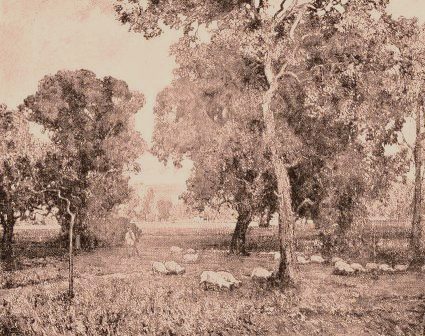
had induced you to paint it. Such are the difficulties one has to contend with in painting a large picture from Nature. The difficulties, of course, diminish with the reduction of size of your canvas, since you have a greater command over the smaller area. If, therefore, you care to make the experiment of painting, say a five- or six-foot picture, direct from Nature, you should, in the first place, make sure that the subject is not liable to rapid change. When you have discovered one that excites your enthusiasm, start by drawing an outline of your composition in charcoal, using as big a stick as possible. When you have done so satisfactorily, re-draw over the lines with a lead pencil, then brush off the charcoal; but before doing so, it is as well either to rub your canvas down with pumice stone or wash it with benzine to take off the greasiness of its surface before starting. That had better be done before you draw upon it.
Now since you have made your drawing you can begin to paint. Set your palette generously. Don't, for heaven's sake, use a starved palette! Be prepared, if I may so express it, to waste all your colour sooner than get a thin picture. Have your dipper big enough to take a large brush. Assuming then that you have set your palette with plenty of white, and the colours arranged as I have already described*, start to paint with confidence. Work freely from your shoulder, with your large canvas upright and at such a height that you can work standing-that is, the centre of the canvas should be a little lower than the palette hand, so that each part can be reached without fatigue. Paint in your large masses broadly-which you will observe in Nature the more readily by half closing your eyes-but in their absolutely correct values and right relation to each other; look for the contours of your lights and darks, then paint fearlessly and frankly. Do not at this stage worry about details, but look for the large things, remembering that the shape of one mass forms the shape of the mass of another. For instance the outline of the trees describes the form of the light of your sky. Your subject must be reduced to its simplest proportions. Broadly speaking, it will comprise but two or three salient quantities. The darkest are your trees, the lightest your sky, with the grass forming a middle tint. Of course this remark is merely a general one. These masses may, and will, vary according to the subject you are painting. But what I insist upon is, that in the preliminary stage of your picture you paint the effect that you wish to secure, and as you cannot begin with details, the only plan is to block in the masses with a big brush while the effect is on. This should be done at a single painting if possible.
Do not trouble about anything else. If for example you cannot paint the whole of the foreground,, paint a passage of it so that it records the exact colour in relation to the trees above it; and proceed in like manner with the sky. It is essential that all these things which are chiefly affected by the rapidly changing effect must receive your attention at the moment, a splash of colour of the right tone is better at this stage than the careful drawing of the contour of a branch, for the one effect is transitory and the other will wait.
Before you commence a large picture, I should strongly advise you to study your subject for some days, and to see it under various aspects and conditions. It is not pleasant to discover,when the Picture is half finished, that it has not been painted under the best effect. Such study is not lost time, for apart from your definite purpose, there is the knowledge you gain of Nature. You become so intimately acquainted with your subject that you know how it is put together, and of what it is composed. You should also make sketches in colour under the same conditions you elect to paint your picture, and also make pencil drawings to familiarise you with its forms. Do not think such
*See Chapter III., Sketching from Nature" (p. z4).
|
2 |